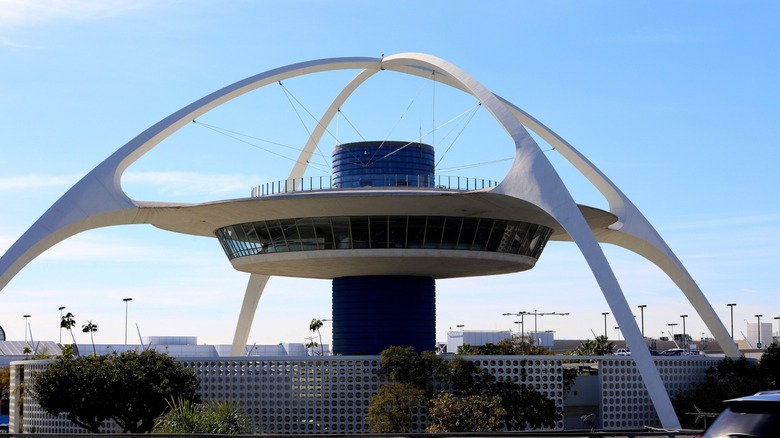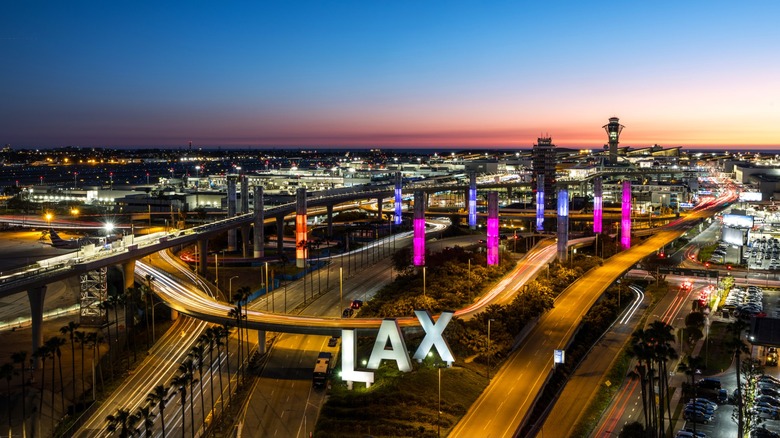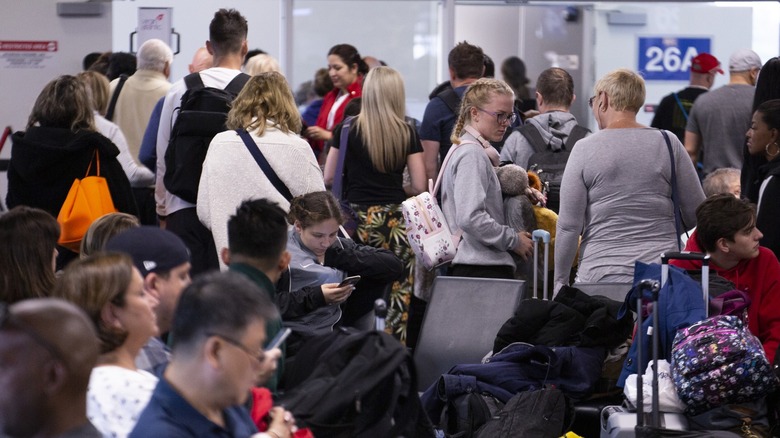How Many Gates Are In The Los Angeles International Airport?
If you've ever visited or passed through Los Angeles International Airport (or its "GTA V" counterpart, Los Santos International Airport), one of the first things you probably noticed was just how large and busy it is. You'll especially get a sense of its size if you ever arrive or depart at one of the gates located at the far end of one of its terminals. It would be tough to manually count each and every gate at Los Angeles International Airport (perhaps better known as LAX) considering you'd have to visit each of the airport's nine terminals. So, if you're wondering exactly how many gates are in LAX, the answer is 161. (Compare that huge number to nearby Hollywood Burbank Airport, which has just 14 gates.)
These 161 gates connect to one of four runways at LAX and are distributed across the giant horseshoe-shaped airport, which is located at 1 World Way in the southwestern part of Los Angeles — right off the Pacific coast. It makes sense that it needs as many gates as it does, because 75 million passengers fly to or from the airport every year. That makes it the fourth busiest airport in the United States.
With so many planes going in and out — and so many people making their way through — it can take you quite a bit of time to reach your gate. It's recommended that travelers departing LAX arrive at their terminal at least two hours before their flight (three hours if flying international) and even earlier if it's during peak travel times. You need so much time to make it to the gate because of both long security lines (you can get stopped by the TSA for the weirdest reasons) but also because of how big the Los Angeles International Airport is.
How big is LAX?
As important as the Los Angeles International Airport is culturally, considering it serves one of America's biggest cities, it doesn't even break the top 10 list of the world's largest airports. However, with enough space for 161 gates, it still takes up quite a bit of real estate — over 2,950 acres, with another of 700 acres of surrounding land also owned by LAX. Los Angeles International Airport started its life in 1928 as the more modest Los Angeles Municipal Airport, which consisted of a single dirt runway. In 1946, it began providing commercial airline service, adding several terminals and expanding in size in the decades since then. Today, the airport is so large that more than 50,000 people work in and around LAX, including providing goods and services for the airport and its visitors.
While LAX doesn't include any of the longest airport runways in the world, it's still large enough to land to any commercial plane actively in service, no matter how big it is — including the massive Boeing 777F and even military transport planes like the C-17 Globemaster III. There are no current plans for the airport to make its runways any larger anytime soon, but it is updating its runway exits and expanding some of its taxiways.
These are just some of the dozens of projects included in a current, multi-year $30 billion renovation effort called TransformingLAX. This extensive overhaul will affect nearly every corner of the airport and will likely add to the 161 gates the airport already has. It's not rare for airports to receive makeovers as populations grow and technology advances, but there is one big reason officials are in a rush to upgrade LAX — and it's arriving in 2028.
All 161 gates at LAX will likely be needed in 2028
The 2020s are a busy decade for the city of Los Angeles. No stranger to big cultural events that draw visitors from all over the globe, two in particular are likely to bring more than usual in 2026 — the NBA All-Star Game and the next FIFA World Cup. However, these are just appetizers to a main course of impending tourism, because Los Angeles is also hosting the 2028 Summer Olympics.
The next Summer Olympics will take place in July 2028, coinciding with LAX's 100th anniversary. In addition to the 15,000 athletes from around the world that will compete, officials are expecting hundreds of thousands — if not millions — of visitors descending upon the city within a roughly two-week period. (Nearly 6 million people attended the Olympics in 1984, the last time they were held in L.A.) Many if not most travelers will be arriving on the runways of LAX and filing through its terminals before exploring the city. All 161 gates, and any added before then, will likely be in constant use.
In addition to technical upgrades to handle more travelers and help move them into the city center (L.A. infamously has very limited transit options servicing its airport), part of LAX's renovations include tourist-friendly luxuries. These include an outdoor Sky Deck, new high-end eateries, and custom art installations. After the Olympics end and visitors go back home, most of these changes will remain in place and join the airport's iconic Theme Building, a space-age structure built near its center in 1961 — making LAX a tourist attraction in its own right. Perhaps, if the renovations are extensive and lavish enough, LAX may even finally join the list of the most luxurious airports in the world.


